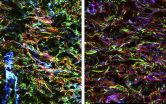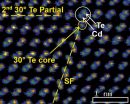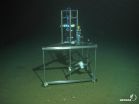INFORMATION:
Panic attacks associated with fear of bright daylight
2014-10-20
(Press-News.org) Berlin, 20 October 2014 Fear of bright daylight is associated with panic disorder, according to new presented at the ECNP congress in Berlin.
Panic disorder is where a person has recurring and regular panic attacks. In the UK, it affects about two in 100 people, and it's about twice as common in women as it is in men1. Previous studies have shown that there is a strong seasonal component in panic disorder, but this is the first study to look specifically at panic disorder patients' reactions to light.
A group of researchers from the University of Siena (Italy) compared 24 patients with panic disorder (PD) against 33 healthy controls. Using a standard Photosensitivity Assessment Questionnaire (PAQ), they found that healthy controls showed a slight (not statistically significant) tendency to be photophilic – to be attracted to bright light. In contrast, the patients with panic disorder showed medium to high levels of aversion to bright light.
The Photosensitivity Assessment Questionnaire asks subjects to agree or disagree with a series of questions about their attitude towards light, for example "My ideal house has large windows" or "Sunlight is so annoying to me, that I have to wear sunglasses when I go out". The mean values in the Photosensitivity Assessment Questionnaire were as follows: patients with photophobia scored 0.34 (± 0.32 SD), healthy subjects scored 0,11 (± 0,13 SD).
According to lead researcher, Dr Giulia Campinoti:
"There have been several hints that photophobia is associated with panic disorder; for example in some people, fluorescent light can induce panic attacks. It had also been noted that people with panic disorder often protect themselves from light, for example by wearing sunglasses.
We believe that photophobia is one of the elements which may increase the risk of people suffering from panic attacks, but this is a small study, so it needs to be confirmed by a longer-term follow-up trial. For example, we need to understand if the photosensitivity and panic attacks continue to be related over time. If we can confirm this, then we may be able to take steps to avoid some of the triggers to panic attacks. It is important to note that our work shows an association, not necessarily a cause and effect. We don't yet know exactly what the relationship might be, but there is probably some underlying biochemical basis".
Commenting for the ECNP, Professor Siegfried Kasper (Vienna) said:
"This is a very interesting study that confirms our previous finding that anxiety components within depression cannot be treated with light therapy".
ELSE PRESS RELEASES FROM THIS DATE:
New research shows fish intake associated with boost to antidepressant response
2014-10-20
Berlin, 20 October 2014 Up to half of patients who suffer from depression (Major Depressive Disorder, or MDD) do not respond to treatment with SSRIs (Selective Serotonin Reuptake Inhibitors). Now a group of Dutch researchers have carried out a study which shows that increasing fatty fish intake appears to increase the response rate in patients who do not respond to antidepressants. This work is being presented at the European College of Neuropsychopharmacology congress in Berlin.
According to lead researcher, Roel Mocking (Amsterdam):
"We were looking for biological ...
Aspirin shown to benefit schizophrenia treatment
2014-10-20
Berlin, 20 October 2014 A new study shows that some anti-inflammatory medicines, such as aspirin, estrogen, and Fluimucil, can improve the efficacy of existing schizophrenia treatments. This work is being presented at the European College of Neuropsychopharmacology conference in Berlin.
For some time, doctors have believed that helping the immune system may benefit the treatment of schizophrenia, but until now there has been no conclusive evidence that this would be effective. Now a group of researchers at the University of Utrecht in the Netherlands has carried out ...
Research reveals likelihood, onset of MS diagnosis among patients with inflammatory eye disease
2014-10-20
CHICAGO – Oct. 19, 2014 – The results of the largest retrospective study of multiple sclerosis (MS) in uveitis patients has revealed that nearly 60 percent of patients with both diseases were diagnosed with each within a five-year span. The study is being presented today at AAO 2014, the 118th annual meeting of the American Academy of Ophthalmology. While it has long been known that there is an association between the eye condition and MS, this is the first study to provide a detailed description of the relative onset of uveitis and MS and to calculate the ...
Chinese power: Challenges and R&D opportunities of smart distribution grids
2014-10-20
After conducting an investigation about the current state of the operation of medium voltage distribution grids and the integration of distributed generation (DG) of renewable resources across China, scientists at the Key Laboratory of Smart Grid, under the auspices of the Ministry of Education, at Tianjin University in the east coast city of Tianjin, set out an array of R&D opportunities to modernize these grids.
Researchers Yu Yixin, Zeng Yuan, Liu Hong and Sun Bing state in a recent paper published on the Beijing-based journal SCIENCE CHINA Technological Sciences that ...
Over-organizing repair cells set the stage for fibrosis
2014-10-20
The excessive activity of repair cells in the early stages of tissue recovery sets the stage for fibrosis by priming the activation of an important growth factor, according to a study in The Journal of Cell Biology.
Myofibroblasts are highly contractile cells that repair damaged tissues by replacing and reorganizing the extracellular matrix (ECM), the meshwork that fills the space around cells, in order to draw a wound closed. When myofibroblasts are not properly regulated, however, they continue to act on healed tissues and produce excessive amounts of ECM. Excessive ...
Towards controlled dislocations
2014-10-20
Crystallographic defects or irregularities (known as dislocations) are often found within crystalline materials. Two main types of dislocation exist: edge and screw type. However, dislocations found in real materials tend to be a mix of these two types, resulting in a complex atomic arrangement not found in bulk crystals. The study of these dislocations in semiconductors is probably as old as the science of semiconductors itself, and the technological importance of dislocations can hardly be overstated. From their roles in the way crystals form to their effects on a material's ...
Cold sores increase the risk of dementia
2014-10-20
Infection with herpes simplex virus increases the risk of Alzheimer's disease. Researchers at Umeå University, Sweden, claim this in two studies in the journal Alzheimer's & Dementia.
"Our results clearly show that there is a link between infections of herpes simplex virus and the risk of developing Alzheimer's disease. This also means that we have new opportunities to develop treatment forms to stop the disease," says Hugo Lövheim, associate professor at the Department of Community Medicine and Rehabilitation, Geriatric Medicine, Umeå University, who is ...
Pediatric allergology: Fresh milk keeps infections at bay
2014-10-20
A study by researchers of Ludwig-Maximilians-Universitaet (LMU) in Munich shows that infants fed on fresh rather than UHT cow's milk are less prone to infection. The authors recommend the use of alternative processing methods to preserve the protectants found in the natural product.
A pan-European study, led by Professor Erika von Mutius, Professor of Pediatric Allergology at LMU and Head of the Asthma and Allergy Department at Dr. von Hauner's Children's Hospital, reports that fresh cow's milk protects young children from respiratory infections, febrile illness and inflammation ...
The breathing sand
2014-10-20
A desert at the bottom of the sea? Although the waters of the North Sea exchange about every two to three years, there is evidence of decreasing oxygen content. If lower amounts of this gas are dissolved in seawater, organisms on and in the seabed produce less energy – with implications for larger creatures and the biogeochemical cycling in the marine ecosystem. Since nutrients, carbon and oxygen circulate very well and are processed quickly in the permeable, sandy sediments that make up two-thirds of the North Sea, measurements of metabolic rates are especially difficult ...
Biomarkers uPA/PAI-1 in breast cancer: Benefit and harm of the test unclear
2014-10-20
To make a decision for or against adjuvant chemotherapy, a test to measure the concentrations of the biomarkers uPA and PAI-1 in the tumour tissue is available for breast cancer patients. However, as suitable studies are lacking, it remains unclear for patients with an intermediate risk of recurrence which benefit or harm a treatment strategy based on this test may have for them. This is the result of the final report published by the Institute for Quality and Efficiency in Health Care (IQWiG) on 20 October 2014.
Adjuvant systemic treatments aim to prolong survival
Even ...




